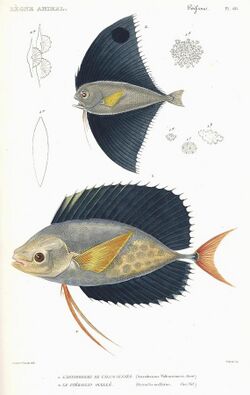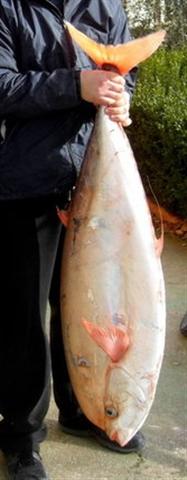Biology:Louvar
| Louvar | |
|---|---|

| |
| Scientific classification | |
| Domain: | Eukaryota |
| Kingdom: | Animalia |
| Phylum: | Chordata |
| Class: | Actinopterygii |
| Order: | Acanthuriformes |
| Family: | Luvaridae |
| Genus: | Luvarus |
| Species: | L. imperialis
|
| Binomial name | |
| Luvarus imperialis Rafinesque, 1810
| |
| Synonyms[2] | |
| |
The louvar or luvar (Luvarus imperialis) is a species of marine ray-finned fish, it is the only extant species in the genus Luvarus and family Luvaridae. This taxon is classified within the suborder Acanthuroidei, which includes the surgeonfish, of the order Acanthuriformes. The juvenile form has a pair of spines near the base of the tail, like the surgeonfish, though they are lost in the adult.
Taxonomy
The louvar was first formally described in 1810 by the French polymath Constantine Samuel Rafinesque with its type locality given as Sicily.[3] Rafinesque described it as the only species in the monospecific genus Luvarus.[4] It is the only extant species in the genus and in the family Luvaridae,[5] the Luvaridae being proposed by Theodore Gill in 1885.[6] The family is included in the suborder Acanthuroidei of the order Acanthuriformes.[7]
Etymology
The louvar's binomial Luvarus imperialis is based on the Sicilian name for this fish, Luvari imperiali, which was used because this species resembles the actual luvari, the common pandora (Pagellus erythrinus). The specific name imperialis means "imperial" or "majestic", perhaps referring to the palatability of its flesh.[8]
Description
The louvar has a robust, ovoid body tapering towards the caudal fin with a small mouth and eyes that are placed low on the head,[9] behind the mouth and beneath a large bulging forehead.[10] The anal and dorsal fins are long-based and are not tall and have no spines,[11] the anal fin has 18 soft rays and the dorsal fins have 20.[2] The caudal fin is large and concave with the slender caudal peduncle having either one or two keels close to the base of the caudal fin. The pelvic fins are tiny while the long pectoral fins have pointed tips. These fishes have a covering of rough skin with very small spines.[11] The overall colour is a metallic bluish-grey with some pinkish or orange tint.[10] The dorsal and caudal fins are reddish.[11] The juveniles have longer dorsal and anal fins than the adults and the origin of these fins is closer to the head. They also have long pelvic fins and teeth in the jaws, features that are lost as they change to adults.[10][11] The louvar has a maximum published total length of 200 cm (79 in), although 152 cm (60 in) is more typical, and a maximum weight of 150 kg (330 lb).[2]
Distribution and habitat
The louvar has an almost cosmopolitan tropical and temperate distribution. It is widespread in the Indo-Pacific region but in the Atlantic the distribution is more localised, although it appears to be less uncommon in the eastern Atlantic than it is in the western Atlantic, and there are a number of widely dispersed records from the Mediterranean.[1] This is an oceanic or epipelagic species found near the surface or in deep water, down to 200 m (660 ft).[2]
Biology
Louvars are solitary[2] carnivores feeding on soft-bodied zooplankton such as jellyfishes and ctenophores.[10] The spawn from the late spring and throughout the summer[2] and each female may lay millions of small pelagic eggs.[10]
Fisheries
Louvars are very rare and are not targeted by fisheries and are normally taken as bycatch.[1] For example, they are hardly ever found in fish markets in the United States, only as bycatch, but is prized as an eating fish.[12] Fish are often removed from markets because of their high parasite load.[1]
References
- ↑ 1.0 1.1 1.2 1.3 Collette, B.B. (2015). "Luvarus imperialis". IUCN Red List of Threatened Species 2015: e.T190116A115308008. doi:10.2305/IUCN.UK.2015-4.RLTS.T190116A15572470.en. https://www.iucnredlist.org/species/190116/115308008. Retrieved 9 July 2023.{{cite iucn}}: error: |doi= / |page= mismatch (help)
- ↑ 2.0 2.1 2.2 2.3 2.4 2.5 Froese, Rainer and Pauly, Daniel, eds. (2023). "Luvarus imperialis" in FishBase. February 2023 version.
- ↑ Eschmeyer, William N.; Fricke, Ron; van der Laan, Richard, eds. "Species in the genus Luvarus". California Academy of Sciences. http://researcharchive.calacademy.org/research/ichthyology/catalog/fishcatget.asp?tbl=species&genus=Luvarus.
- ↑ Eschmeyer, William N.; Fricke, Ron; van der Laan, Richard, eds. "Genera in the family Luvaridae". California Academy of Sciences. http://researcharchive.calacademy.org/research/ichthyology/catalog/fishcatget.asp?tbl=genus&family=Luvaridae.
- ↑ Froese, Rainer, and Daniel Pauly, eds. (2023). "Luvaridae" in FishBase. February 2023 version.
- ↑ Richard van der Laan; William N. Eschmeyer; Ronald Fricke (2014). "Family-group names of Recent fishes". Zootaxa 3882 (2): 001–230. doi:10.11646/zootaxa.3882.1.1. PMID 25543675. https://www.researchgate.net/publication/268078514.
- ↑ J. S. Nelson; T. C. Grande; M. V. H. Wilson (2016). Fishes of the World (5th ed.). Wiley. pp. 497–502. ISBN 978-1-118-34233-6. https://sites.google.com/site/fotw5th/.
- ↑ Christopher Scharpf; Kenneth J. Lazara, eds (12 January 2021). "Order ACANTHURIFORMES (part 2): Families EPHIPPIDAE, LEIOGNATHIDAE, SCATOPHAGIDAE, ANTIGONIIDAE, SIGANIDAE, CAPROIDAE, LUVARIDAE, ZANCLIDAE and ACANTHURIDAE". The ETYFish Project Fish Name Etymology Database. Christopher Scharpf and Kenneth J. Lazara. https://etyfish.org/acanthuriformes2/.
- ↑ Mark McGrouther (31 March 2021). "Louvar, Luvarus imperialis Rafinesque, 1810". Australian Museum. https://australian.museum/learn/animals/fishes/louvar-luvarus-imperialis/.
- ↑ 10.0 10.1 10.2 10.3 10.4 Dianne J. Bray. "Luvarus imperialis". Fishes of Australia. Museums Victoria. https://fishesofaustralia.net.au/home/species/1048.
- ↑ 11.0 11.1 11.2 11.3 "Louvar". Mexican Fish. https://mexican-fish.com/louvar/.
- ↑ "Louvar: A Fish You May Never Taste.". Larry Levine, Table Talk at Larry's. January 3, 2012. http://www.tabletalkatlarrys.com/index.php/2012/01/louvar-a-fish-you-may-never-taste-or-even-see.
External links
- "Luvarus imperialis". Integrated Taxonomic Information System. https://www.itis.gov/servlet/SingleRpt/SingleRpt?search_topic=TSN&search_value=172485. Retrieved 18 April 2006.
- "Louvar". Australian Museum Fish Site. http://www.amonline.net.au/fishes/fishfacts/fish/limperialis.htm. Retrieved 31 March 2006.
- "Phylogenetic Revision of the Fish Families Luvaridae and †Kushlukiidae (Acanthuroidei), with a New Genus and Two New Species of Eocene Luvarids" Contains information about Luvaridae and Kushlukiidae (Acanthuroidei).
Wikidata ☰ Q1208946 entry
 |




